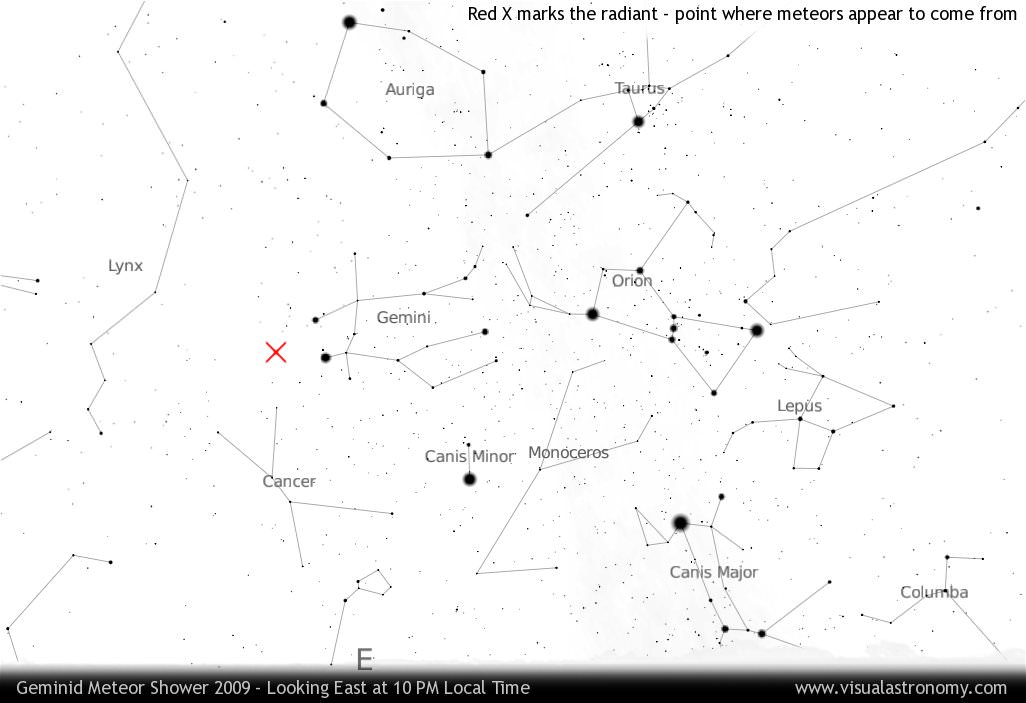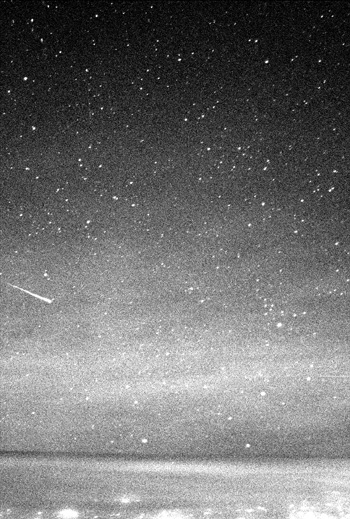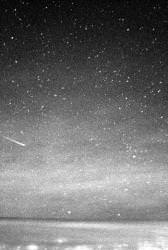Amateur astronomers around the world will be watching for what is predicted to be one of the year’s best meteor showers, the Geminids. Join in and make it a global experience with another #Meteorwatch on Twitter. #Meteorwatch, which occurred during the Perseid meteor shower in mid-August, is a social media astronomical event that was a big hit among Twitterers. But there’s lots of ways to join in, not only on Twitter. Everyone is welcome whether they are an astronomer or just have an interest in the night sky. The aim is to get as many people to look up as possible and maybe see meteors or even some fireballs for the first time.
Continue reading “Join the World in Looking for Geminids This Weekend with #MeteorWatch”
Solo Sailor Spots Pacific Bolide

A 16-year-old high school girl who is attempting to sail solo around the world spotted a bright bolide over the Pacific Ocean during the peak of last week’s Leonid meteor shower. The International Meteor organization relies on reports just like this from observers in the field….or in this case “all at sea”.
Jessica Watson a student from Queensland, Australia, has set off on the adventure of a lifetime, attempting to become the youngest woman to sail solo and unassisted around the world.
Tips for Viewing the Geminid Meteor Shower
Occurring every year in mid-December, the Geminid meteor shower is commonly referred to as the most reliable meteor shower of the year. That is, it almost always puts on a great show!
The Geminid meteor shower is sure to be a stunning show this year, as the Moon will not be visible at night, so its glow will not impede your meteor viewing ability. In addition, the Geminids’ radiant is favorably positioned for most viewers at this time of year. In order to see the most meteors, I suggest the following tips:
- The Geminid meteor shower has a very broad maximum peak. Because of this, the night on which you view the meteors isn’t critical. You will of course, see more meteors on the peak nights. This year the Geminid meteor shower’s peak is the night of December 13th-14th, 2009.
- The best time to view a meteor shower is in the late night to early morning hours. The best time to view a meteor shower typically begins around 2 AM. This is because as the Earth rotates toward dawn, the forward velocity of the planet adds to the linear velocity of the surface and atmosphere. This has the effect of “sweeping up” more meteors.
- If you’re not normally awake at 2 AM, like many people, simply go to sleep very early and set an alarm clock to wake you up to view the meteor shower. Trust me on this point, it is definitely worth it.
- The Geminid meteor shower’s radiant is right near the twin bright stars Castor and Pollux in Gemini. Click the image at top right to see a map (thanks to Stellarium). The trick, however, isn’t to look towards the radiant, but to keep your eyes on the whole sky. While it’s impossible to look at the whole sky, just keep your eyes scanning and alert. This increases your chances of seeing a fleeting meteor or one out of the corner of your eye.
- Darkness is key to proper meteor shower viewing. If you live in a city or other light polluted area, try going to a dark sky site to truly experience a meteor shower. You might be surprised how close a dark sky site is to you! Here are some tips on finding a dark sky near you.
- Dress warm! The cold December air will seem extra cold, since you’ll be sitting outside, inactive for the most part. I also have some tips on cold-weather astronomy at Visual Astronomy. If you are too cold, go inside for a bit! Your safety is not worth seeing some meteors!
- Keep comfortable, too! I’ve found the best way to watch meteor showers is either laying down in a sleeping bag, or on an Adirondack or other reclining lawn chair. This allows you to keep your eyes on the sky without straining your neck!
- Keep safe! If you’re traveling to an unknown or unfamiliar area to watch the meteor shower, don’t travel alone! Take a buddy with you. Not only is this great for safety, but meteor showers should be a social event, and are fun to share with a friend!
- Green lasers are great for pointing out celestial objects. I use one to point out objects to people, and it works much better than trying to point with your hand. Just be careful with it and do not use a laser more powerful than 5 mW.
- Finally, if you’re feeling ambitious, take pictures! This is a real challenge, but if you’re up to it, it’s a very rewarding challenge. You’ll need a tripod and a camera that can take long exposures. Set your exposure for somewhere around 30 seconds and let it record the whole sky. If a meteor crosses the field of view, it will be captured, and you can keep it forever!
So using these tips, you can get the most out of your Geminid viewing experience!
62 New Meteor Showers to Enjoy
[/caption]
Earth is constantly plowing through meteoric debris, and any given night stargazers can spot a shooting star or two. A seven year survey by astronomers at the University of Western Ontario has identified 117 new meteor showers, 62 of which have never been reported before. It’s not that there are more meteors to see and enjoy these days, but the paths of the debris particles have been tracked, allowing researchers to trace the debris’ orbits around the sun and track down their parent bodies. Next, the big job will be naming these different showers. Right now there are only 64 recognized and named meteor showers and over 300 other showers that have yet to be authorized by the International Astronomical Union.
The meteor survey uses radar to detect the trail of ionized gases the debris produces produced as they speed through atmosphere and disintegrate. The radar can detect debris about 10 times as small as what the naked eye can see, spotting objects about 0.1 millimetres across.
New Scientist reports that the research team found that about half of the 117 observed streams follow orbits similar to those from other meteor showers. That bolsters previous research suggesting that the parent objects – mostly comets – likely broke up into smaller bodies that also shed debris trails – a break-up process that can occur over and over.
“In some cases, we can still trace [the trails] back to some parent objects; in others, we can’t see an obvious parent,” said team leader Peter Brown in New Scientist. For example, the team found half a dozen streams linked to Comet Encke, the parent body of the well-known Taurid meteor shower.
See this IAU page for a list of all discovered and established meteor showers.
Source: New Scientist
Meteor Shower Throws Over 100 Meteors per Hour
With over 100 meteors per hour, the Quadrantid Meteor Shower is one of the latest mergers between Google and NASA, a major asset to space research due to their successful combination of ideas and plans. This peak shower began around 0200 UTC on Friday morning, January 4th, with the jet owned by the founders of Mountain View-based Google flying amongst big science players, such as the SETI research team.
To see this spectacular sight and to partake in a scientific mission, Google carried a team of NASA scientists and their high-technology instruments on board the Google owned Gulfstream V jet, which left the Mineta San Jose International Airport on Thursday late afternoon about 4:30 p.m. Plans were made for a ten-hour flight over the Arctic, returning to home base when the meteor shower mission was accomplished with the resulting data.
The GOOG Google.com Stock Message Board is full of the things that Google has been doing to improve the world—a real biggie was to develop a cheaper solar, wind power for Earth—excellent idea from a company whose corporate motto is to “do not be evil.â€? That plan involved the creation of a research group to develop energy sources that was a cheaper renewable alternative which focuses on solar, wind and any other forms of power through the Renewable Energy “Cheaper Than Coalâ€? project. And of course, lowering Google’s power bill was top of the list before anyone else as a huge incentive.
Last September, as most are aware of, NASA and Google had launched a $2.6 million dollar agreement to let the Google co-founders house their aircraft at Moffett Field while NASA was to be allowed to use it for their science work, such as that of the Quadrantid Meteor Shower. Other prospective plans for Google are to hand out $30 million dollars to any company that successfully comes up with a plan to bring people to the moon. Another plan is to fund a space race through Google’s Lunar X Prize competition.



